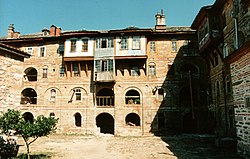Great Lavra
| Μεγίστη Λαύρα | |

External view of the monastery.
|
|
| Monastery information | |
|---|---|
| Full name | Holy Monastery of Great Lavra |
| Order | Ecumenical Patriarchate |
| Dedicated to | Annunciation of the Blessed Virgin |
| Diocese | Mount Athos |
| People | |
| Founder(s) | Athanasius the Athonite |
| Prior | Archimandrite Elder Prodromos |
| Site | |
| Location | Mount Athos, Greece |
| Coordinates | 40°10′16″N 24°22′58″E / 40.171111°N 24.382778°ECoordinates: 40°10′16″N 24°22′58″E / 40.171111°N 24.382778°E |
| Public access | Men only |
The Monastery of Great Lavra (Greek: Μονή Μεγίστης Λαύρας) is the first monastery built on Mount Athos. It is located on the southeastern foot of the Mount at an elevation of 160 metres. The founding of the monastery in AD 963 by Athanasius the Athonite marks the beginning of the organized monastic life at Mount Athos. At the location of the monastery, there was one of the ancient cities of the Athos peninsula, perhaps Akrothooi, from which the sarcophagi of the monastery that are in the oil storage house come. The history of the monastery is the most complete compared to the history of the other monasteries, because its historical archives were preserved almost intact. It is possible that the study of these archives may contribute to the completion of the knowledge of the history of other monasteries, whose archives were partially or completely lost.
The founder of Great Lavra, Athanasius, began the construction of the buildings in 963, according to the will of his friend and Byzantine Emperor Nikephoros II Phokas who funded the project. Nikephoros had promised Athanasius that he would soon become a monk of Great Lavra but the circumstances and his death canceled those plans. However, a permanent imperial grant, which was doubled by John I Tzimiskes, allowed the integration of the buildings. The emperors gave also the Great Lavra many other lands of property including the island of Saint Eustratius and the Monastery of Saint Andreas in Thessaloniki. This led to the growth of the monks from 80 to 120.
The building project, according to the biography of Athanasius the Athonite (11th century), began with the protective wall and continued to the church and cells. After Athanasius' death, the monastery continued its operation normally. The emperors favored its development and during the 11th century there were 700 monks, while smaller monasteries had been ceded to Great Lavra. In the 14th century the monastery suffered, like all the other monasteries of Mount Athos, from Catalan and other pirates. The result of the crisis was the formation of a peculiar way of monasticism, the Idiorrhythmic Way, despite the objections of the official Church and the emperors. In 1574, the Patriarch of Alexandria, Sylvester, helped and the monastery operated again under cenobitic monasticism, but soon the peculiar monasticism was again introduced. In 1655, the Patriarch Dionysios III, who also became a monk, donated his personal fortune for the return to the cenobitic life but again these attempts were insufficient and the peculiar monasticism remained until the 20th century (1914), when there were new attempts for the return to the cenobitic life but without results. Since 1980 the monastery has been cenobitic.
...
Wikipedia

